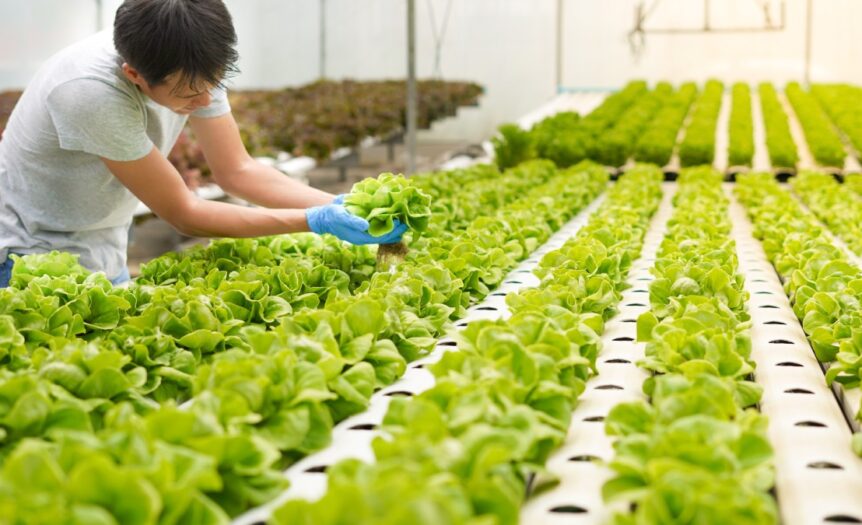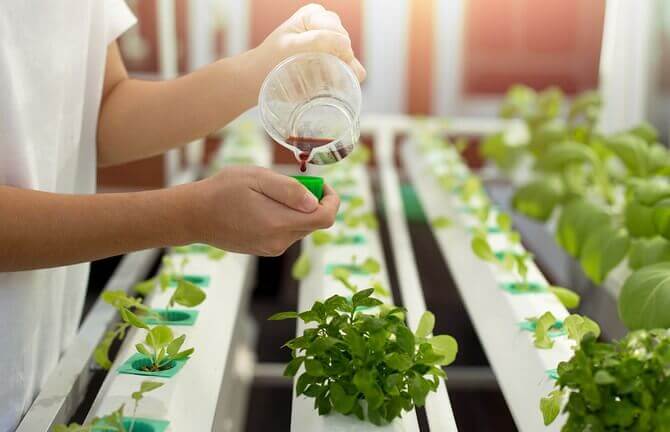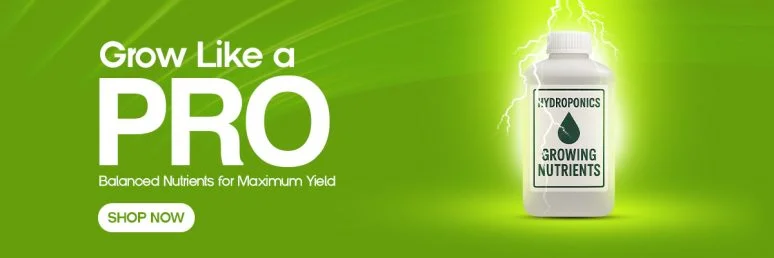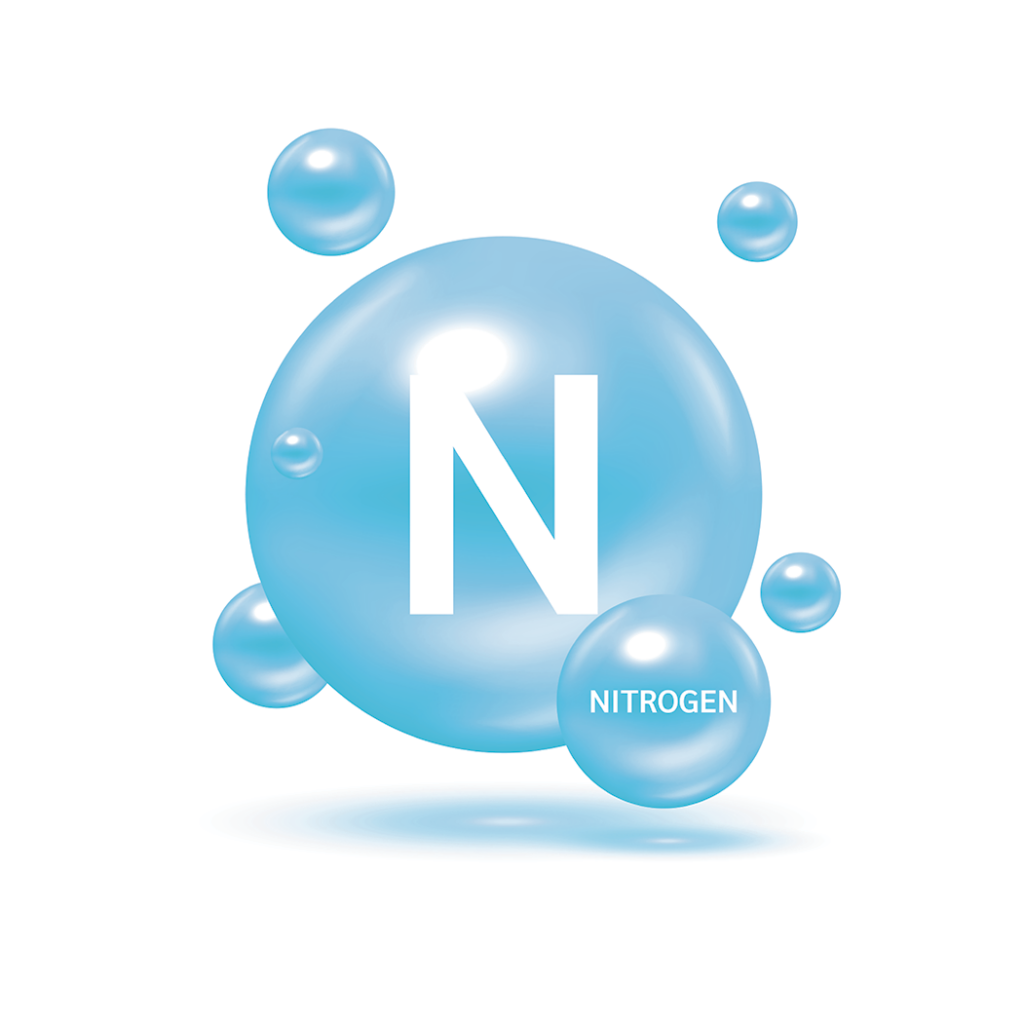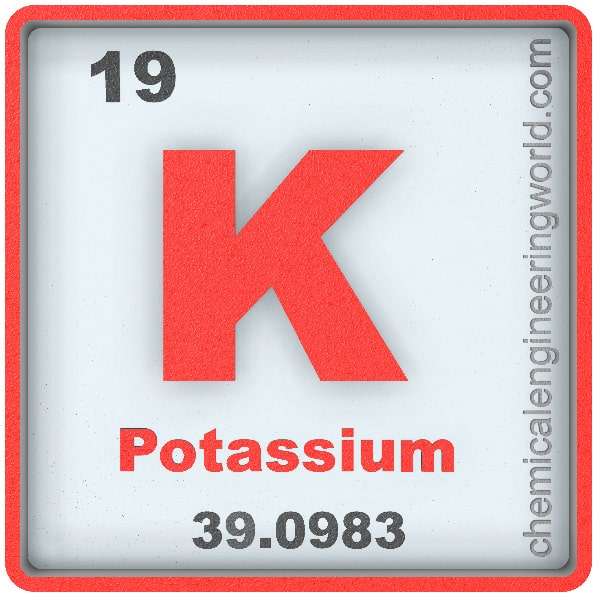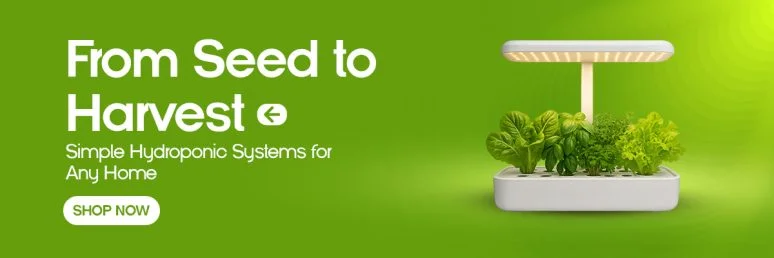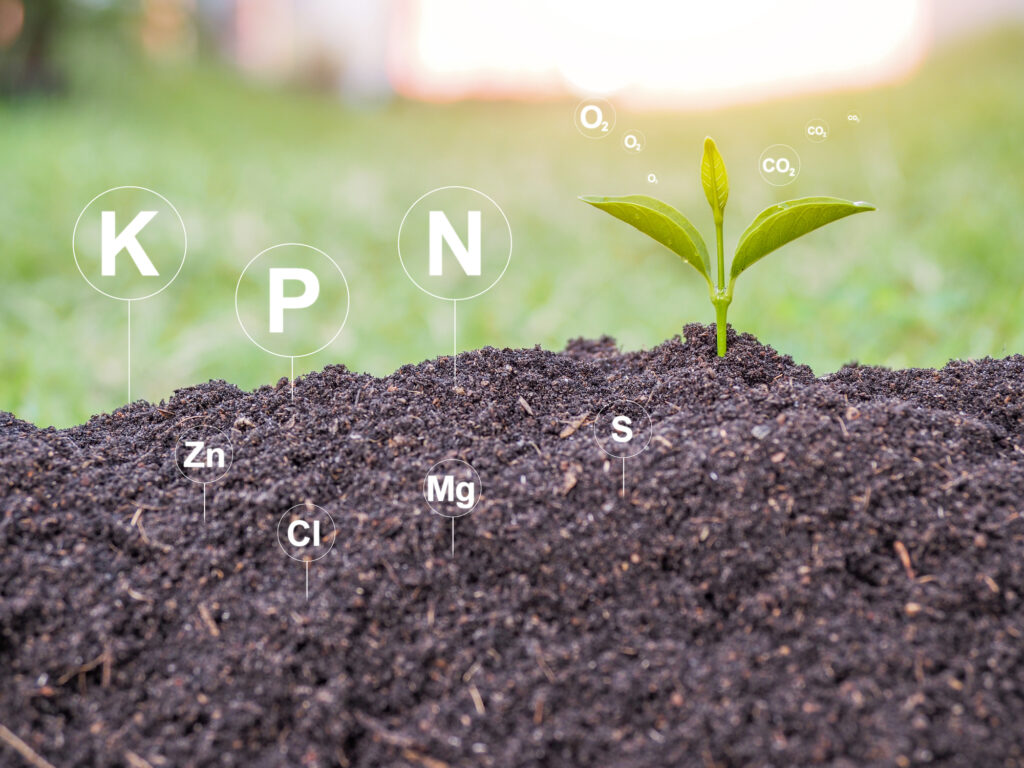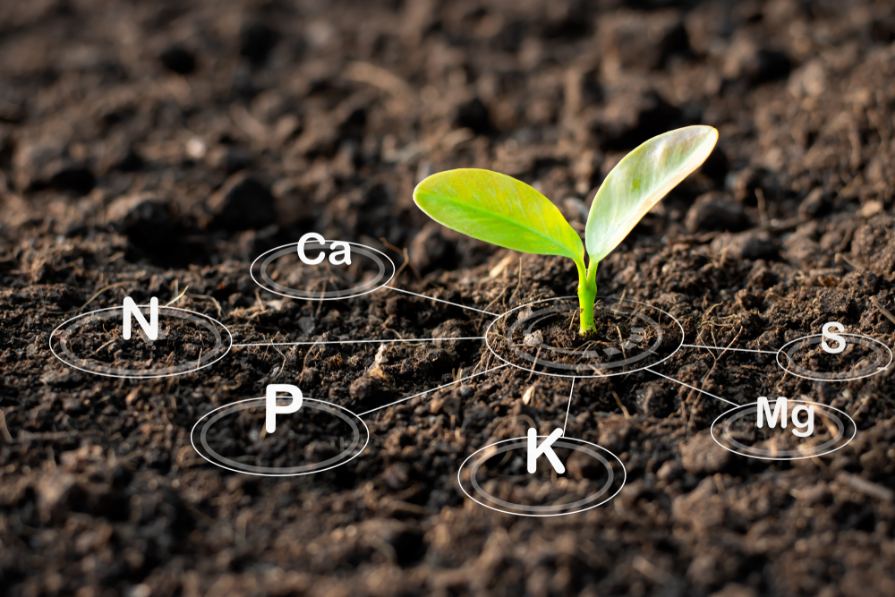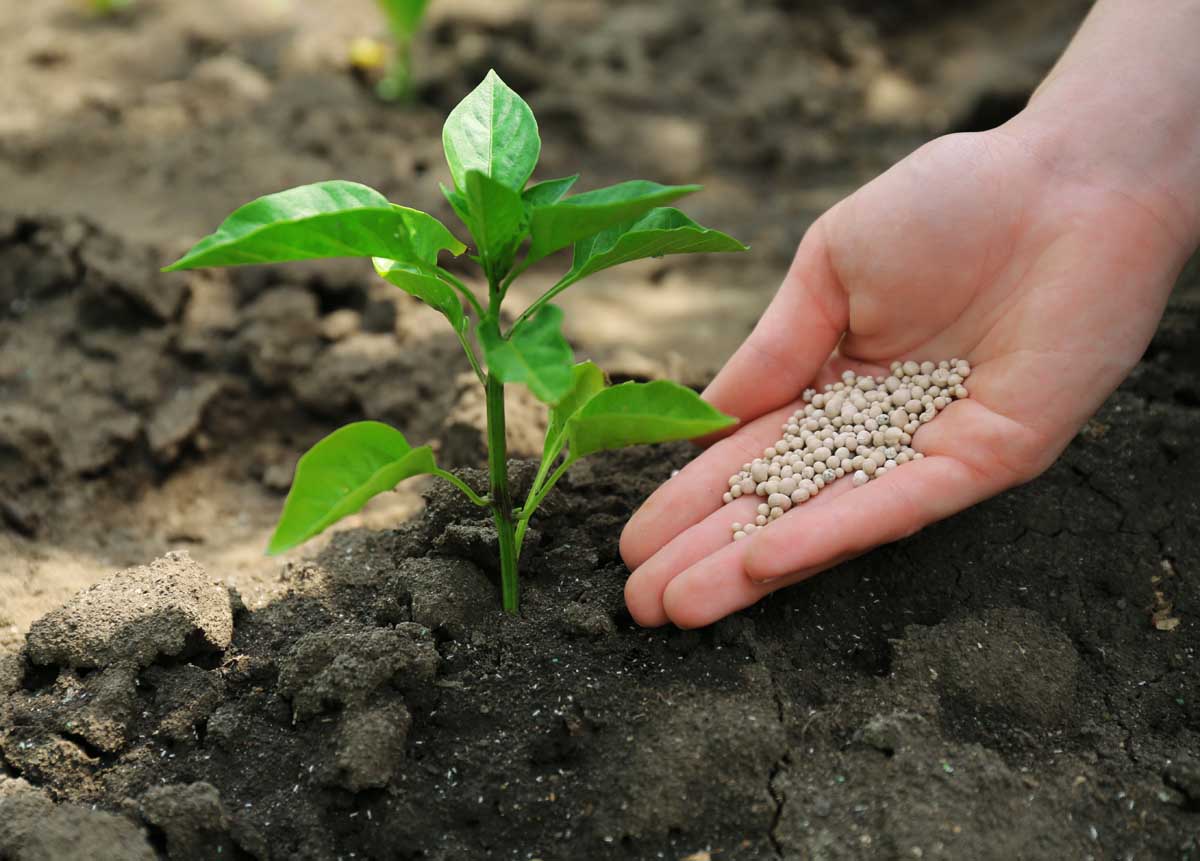Hydroponic Fertilizer NPK Ratio: 4 Very Important Fertilizers

Key Takeaways
- The optimal NPK ratio in hydroponic systems varies by growth stage: seedlings benefit from a 2-1-2 ratio, vegetative growth requires 3-1-2, and flowering/fruiting plants need a 1-2-3 ratio.
- Hydroponic fertilizers require different NPK ratios than soil-based growing because nutrients are directly delivered to plant roots without soil buffering.
- Regular testing of EC (electrical conductivity) and pH levels is essential for maintaining proper nutrient balance and preventing deficiencies or toxicities.
- Calcium is considered the “fourth essential nutrient” in hydroponics and requires special attention to prevent common issues like blossom end rot.
- Hydrotek Hydroponics offers specialized nutrient calculators to help growers determine the exact NPK formulations needed for specific crops and growth stages.
Finding the perfect nutrient balance is the make-or-break factor for hydroponic growing success. Without soil to buffer nutrient delivery, your plants rely entirely on the solution you provide. The NPK ratio—representing nitrogen, phosphorus, and potassium—forms the backbone of your hydroponic feeding strategy and directly impacts everything from leaf development to flowering potential.
Unlike soil-based gardening where nutrients can be stored and released over time, hydroponics delivers nutrition directly to plant roots. This direct delivery system means you’ll need precise control over your NPK ratios to achieve optimal growth at each stage of your plants’ development. Hydrotek Hydroponics specializes in helping growers understand these critical nutrient relationships, offering both pre-mixed solutions and customized formulation advice based on specific crop needs.
With hydroponics, you’re not just feeding plants—you’re becoming their life support system. The difference between thriving crops and struggling plants often comes down to understanding the science behind these three essential macronutrients and how they work together.
What Every Hydroponic Grower Needs to Know About NPK Ratios
“Growers Prefer Hydroponic Farming …” from thefloridavillager.com and used with no modifications.
Success in hydroponic growing hinges on understanding that NPK isn’t just a random set of letters and numbers on fertilizer packaging—it’s the foundation of plant nutrition. These three elements make up about 75% of what your plants need to thrive, working together in a delicate balance that changes throughout the growing cycle. Most commercial hydroponic fertilizers highlight these numbers prominently because they represent the percentage by weight of nitrogen (N), phosphorus (P), and potassium (K) in the product.
Think of NPK as your plants’ primary fuel source. Nitrogen drives leafy green growth, phosphorus builds strong roots and supports flowering, while potassium enhances overall plant health and disease resistance. Without the right balance, plants will show stress signals through discolored leaves, stunted growth, or poor fruit development. The best hydroponic fertilizers provide these nutrients in forms that are immediately available to plants, unlike soil fertilizers that may contain slow-release components.
A common misconception is that more nutrients always equal better growth. In reality, excess nutrients can be just as harmful as deficiencies, causing toxicity, nutrient lockout, or salt buildup in your system. This is why understanding the specific NPK needs of your crops at different growth stages is critical for hydroponic success.
The Science Behind NPK: Your Plants’ Primary Fuel Source
“Nutrients for hydroponic farming and …” from growdirector.com and used with no modifications.
At the molecular level, NPK elements function as building blocks for essential plant processes. Nitrogen forms amino acids and proteins, phosphorus creates energy-transfer molecules like ATP, and potassium regulates water movement and enzyme activation. This trio works in concert, with each element supporting and enhancing the functions of the others in a complex biochemical dance.
When plants absorb these nutrients through their roots, they’re converted into compounds that fuel everything from cell division to photosynthesis. The beauty of hydroponics lies in delivering these nutrients in their most bioavailable forms, allowing for faster uptake and more efficient use than soil-based growing. This direct delivery system is why hydroponic plants can grow up to 25% faster than their soil-grown counterparts when properly fed.
What Those Three Numbers Actually Mean
The three numbers separated by hyphens on fertilizer packaging (like 10-5-8) represent the percentage by weight of nitrogen (N), phosphorus (P), and potassium (K) in that exact order. For example, a 100-pound bag of 10-5-8 fertilizer contains 10 pounds of nitrogen, 5 pounds of phosphorus (in the form of P₂O₅), and 8 pounds of potassium (as K₂O). These percentages help you calculate precisely how much of each nutrient you’re adding to your hydroponic system.
It’s important to note that these numbers don’t include the many other nutrients plants need—they only reflect the primary macronutrients. Complete hydroponic nutrients also contain secondary macronutrients (calcium, magnesium, sulfur) and micronutrients (iron, manganese, zinc, etc.) that aren’t reflected in the NPK ratio but are equally essential for plant health.
When comparing different products, pay attention to both the ratio between the numbers and their absolute values. A 3-1-2 ratio could be represented as 3-1-2, 6-2-4, 9-3-6, etc. While the proportions remain the same, higher numbers mean more concentrated nutrients, affecting how much product you’ll use and how frequently you’ll need to replace your solution.
Why Hydroponics Demands Different NPK Ratios Than Soil
Soil acts as both a nutrient reservoir and buffer, storing minerals and releasing them gradually as plants need them. It also contains beneficial microorganisms that break down organic matter into plant-available nutrients. In hydroponics, you eliminate this entire ecosystem, replacing it with a precisely controlled solution that delivers nutrients directly to plant roots.
This direct delivery means hydroponics requires more precisely calibrated NPK ratios, often at lower overall concentrations than soil fertilizers. While a soil gardener might use a general-purpose 10-10-10 fertilizer, hydroponic growers typically need more specialized ratios tailored to specific growth stages. Additionally, hydroponic nutrients must be completely water-soluble to prevent clogging systems and ensure consistent nutrient delivery.
The Critical Balance: Too Much Is Just As Harmful As Too Little
The difference between nutrient deficiency and toxicity can be surprisingly narrow in hydroponics. Excess nutrients don’t just waste money—they can actually harm plants by causing nutrient burn, lockout (where the presence of too much of one nutrient prevents the absorption of others), or toxic salt buildup in your system. This is why regular testing of your nutrient solution’s electrical conductivity (EC) and pH is essential for maintaining the perfect balance.
Plants show stress from improper NPK ratios through visual cues: nitrogen deficiency appears as yellowing older leaves, phosphorus deficiency manifests as purple stems and undersized growth, and potassium shortage results in brown leaf edges and weak stems. Excesses can be equally problematic, with symptoms ranging from burnt leaf tips to stunted growth. Learning to read these signs allows you to adjust your nutrient solution before serious damage occurs.
Nitrogen (N): The Growth Powerhouse
“Cannabis Growth …” from www.plantprod.com and used with no modifications.
Nitrogen stands as the most consumed nutrient in a plant’s diet, particularly during vegetative growth phases. This essential element makes up approximately 3-4% of a plant’s dry matter and serves as the primary building block for amino acids, proteins, chlorophyll, and genetic material. Without adequate nitrogen, plants simply cannot create new cells or maintain existing ones.
The availability of nitrogen directly determines how quickly your plants grow and how lush their foliage becomes. In hydroponics, nitrogen is typically supplied in two forms: nitrate (NO₃) and ammonium (NH₄). Most hydroponic solutions favor nitrate as the predominant form because it’s more stable in solution and less likely to cause pH fluctuations than ammonium.
Why Nitrogen Is Crucial for Leaf Development
Nitrogen’s most visible role is in leaf production and expansion. As the central component of chlorophyll (the molecule that gives plants their green color and enables photosynthesis), nitrogen directly influences how efficiently plants convert light into energy. Plants with optimal nitrogen levels develop broad, deep green leaves that maximize light capture and energy production, creating a positive growth cycle where more energy leads to more growth, which captures more light, and so on.
Best Hydroponic Nitrogen Sources
The most effective hydroponic nitrogen sources include calcium nitrate, potassium nitrate, and magnesium nitrate. These compounds offer the dual advantage of providing nitrogen in the preferred nitrate form while simultaneously delivering other essential nutrients. For instances where plants need a quick nitrogen boost, ammonium nitrate can be used sparingly, though it should never dominate your nitrogen supply due to its potential to destabilize solution pH.
For organic hydroponic growers, options include liquid fish fertilizers and amino acid supplements, though these require careful filtering and may introduce organic matter that could promote unwanted microbial growth in your system. Regardless of source, nitrogen compounds should be completely water-soluble to prevent clogging and ensure uniform distribution throughout your system.
Signs of Nitrogen Deficiency vs. Excess
Nitrogen deficiency first appears in older leaves, which turn pale green then yellow as the plant relocates nitrogen from aging tissue to support new growth. Left uncorrected, the yellowing progresses upward through the plant, growth slows dramatically, and stems may take on a reddish or purple hue. Flowering plants experiencing nitrogen deficiency often produce smaller blooms and reduced yields. For more information on nutrient balance, check out this article on NPK ratio and nutrient balance.
Conversely, excess nitrogen creates oversized, dark green leaves that appear lush but are actually weaker and more susceptible to disease. Plants may grow tall with elongated stems and increased spacing between nodes—a condition called “stretching.” Flowering plants with too much nitrogen typically delay blooming, focusing instead on vegetative growth, and when they do flower, they produce fewer, smaller blooms. The key is finding the balance where nitrogen levels support robust growth without inhibiting reproductive development.
Adjusting Nitrogen Levels Throughout Plant Life Cycles
As plants transition from vegetative growth to flowering and fruiting, their nitrogen requirements change significantly. Seedlings and young plants need moderate nitrogen levels to establish healthy root systems and initial foliage. During peak vegetative growth, nitrogen requirements surge as plants rapidly produce new leaves and stems, often requiring a solution where nitrogen is the dominant macronutrient.
Once plants begin flowering, nitrogen needs decrease substantially. Excess nitrogen during this stage can actually inhibit flower formation and reduce yields. This is why many experienced growers switch to a “bloom” formula with lower nitrogen and higher phosphorus and potassium as plants enter their reproductive phase. Understanding these changing requirements and adjusting your nutrient solution accordingly represents one of the most important aspects of successful hydroponic cultivation.
Phosphorus (P): The Root and Flower Developer
“File:Electron shell 015 Phosphorus …” from en.m.wikipedia.org and used with no modifications.
While phosphorus constitutes a smaller percentage of a plant’s composition than nitrogen, its role is no less crucial. This element serves as the energy currency in plants, forming the backbone of ATP (adenosine triphosphate)—the molecule that stores and transfers energy within cells. Phosphorus also plays a vital role in root development, flowering, seed formation, and overall plant maturation.
In hydroponics, phosphorus is typically supplied as phosphate (PO₄), which plants can directly absorb without the microbial conversion required in soil. This immediate availability is one reason why hydroponic plants often develop more extensive root systems than their soil-grown counterparts when properly fed. For more information on nutrient balance, you can explore this guide on NPK ratio and nutrient balance.
How Phosphorus Strengthens Root Systems
Strong roots form the foundation of healthy plants, and phosphorus plays a starring role in root development. During germination and early growth, phosphorus stimulates root formation and elongation, helping plants establish the extensive root networks needed to absorb water and nutrients efficiently. Plants with adequate phosphorus develop thicker, more branched root systems that increase their nutrient absorption capacity and provide greater anchorage.
Beyond initial development, phosphorus continues to drive root health throughout the plant’s life cycle. This ongoing support becomes particularly important in hydroponic systems where roots are continuously exposed to nutrient solution and may face stresses like temperature fluctuation or oxygen limitation. Sufficient phosphorus helps roots maintain their integrity and function under these conditions, improving overall system resilience.
Top Phosphorus Sources for Hydroponic Systems
Monopotassium phosphate (MKP) stands as the hydroponic grower’s preferred phosphorus source, delivering highly soluble phosphate along with potassium—another essential macronutrient. For situations requiring additional phosphorus without extra potassium, phosphoric acid can serve as both a phosphorus source and a pH adjustment tool, though it must be used cautiously to avoid dramatic pH drops.
Other viable options include diammonium phosphate (DAP) and monoammonium phosphate (MAP), though these introduce ammonium nitrogen which must be factored into your overall nitrogen balance. Regardless of source, phosphorus compounds should be thoroughly dissolved and mixed separately from calcium-containing solutions to prevent the formation of insoluble calcium phosphate that can precipitate out of solution and clog system components.
Spotting Phosphorus Problems in Your Plants
Phosphorus deficiency often manifests subtly at first, making it easy to overlook until significant damage has occurred. Initial symptoms include stunted growth and unusually dark green foliage that may develop a purple or reddish tint on the undersides of leaves and along stems. As deficiency progresses, older leaves may develop necrotic spots, plants remain smaller than expected, and root development appears restricted.
Excess phosphorus rarely causes direct toxicity symptoms but can induce deficiencies in other nutrients—particularly zinc, iron, and copper—by interfering with their absorption. Plants experiencing these secondary deficiencies may show interveinal chlorosis (yellowing between leaf veins) despite adequate micronutrients in the solution. Finding the right phosphorus balance is especially important during the transition to flowering, when phosphorus requirements increase substantially.
Potassium (K): The Plant Protection Element
“Potassium Element Properties and …” from chemicalengineeringworld.com and used with no modifications.
Potassium stands as the unsung hero of plant nutrition, working behind the scenes to regulate over 60 enzymatic systems within plants. Unlike nitrogen and phosphorus, potassium doesn’t become part of plant tissues but instead functions as an activator and regulator. This mobile nutrient helps control water uptake, regulate stomata opening and closing, and strengthen cell walls—making it crucial for plant stress resistance.
In hydroponic systems, potassium’s role becomes even more prominent as plants face unique stresses not present in soil cultivation. The absence of soil’s buffering capacity means plants rely entirely on the nutrient solution for their potassium needs. Proper potassium levels help plants maintain turgor pressure, resist disease, and develop strong stems that support heavy fruit loads.
Potassium’s Role in Disease Resistance
Potassium serves as a plant’s first line of defense against pathogens and environmental stressors. By strengthening cell walls and regulating water movement, adequate potassium helps plants resist fungal invasion and bacterial infection. Studies have shown that plants with optimal potassium levels produce more protective compounds when challenged by pathogens, effectively creating their own natural immune response.
Beyond disease protection, potassium enhances drought tolerance by regulating water use efficiency. Plants with sufficient potassium can better control water loss through transpiration, allowing them to maintain photosynthesis even under water stress conditions. This resilience factor makes potassium particularly valuable in recirculating hydroponic systems where water quality and temperature can fluctuate.
Reliable Potassium Sources for Hydroponics
Potassium nitrate and monopotassium phosphate serve as the workhorses of potassium supplementation in hydroponics, delivering potassium alongside other essential macronutrients. For situations requiring additional potassium without extra nitrogen or phosphorus, potassium sulfate provides an excellent option while simultaneously supplying beneficial sulfur. Potassium silicate offers the dual advantage of providing potassium while increasing plants’ natural resistance to environmental stress through silicon supplementation.
When selecting potassium sources, consider their effects on solution pH and EC. Potassium hydroxide, for example, dramatically raises pH and should be used primarily as a pH adjuster rather than a primary potassium source. All potassium compounds should be completely water-soluble to prevent precipitation and ensure uniform distribution throughout your system.
Identifying and Fixing Potassium Imbalances
Potassium deficiency typically appears first in older leaves as chlorosis (yellowing) along leaf margins that eventually turns brown and necrotic. As deficiency progresses, leaf edges may curl upward, and plants develop weak stems prone to breaking. Fruit quality suffers significantly, with reduced sugar content and poor shelf life. These symptoms often appear during heavy fruiting when potassium demand peaks, catching even experienced growers by surprise.
Excess potassium rarely causes direct toxicity but can induce calcium and magnesium deficiencies through competitive uptake. Plants experiencing these secondary deficiencies may show interveinal chlorosis and stunted new growth despite adequate calcium and magnesium in the solution. The key is maintaining proper ratios between these competing elements, typically aiming for a potassium:calcium:magnesium ratio of approximately 4:2:1 by weight.
Calcium: The Fourth Essential Nutrient
“Calcium: What do we use it for and …” from www.bwbtech.com and used with no modifications.
Though not included in the NPK rating, calcium deserves special consideration in hydroponics. This immobile nutrient serves as cellular cement, forming calcium pectate compounds that hold cell walls together. Unlike the NPK elements, calcium moves primarily with water through the xylem and cannot be redistributed from older to newer growth when deficiencies occur.
Calcium’s critical role in cell wall structure makes it essential for developing strong plants resistant to disease and environmental stress. In fruit-bearing crops, calcium deficiency leads to disorders like blossom end rot in tomatoes and peppers, bitter pit in apples, and tip burn in lettuce—making adequate calcium supply a make-or-break factor for successful harvests.
Why Calcium Deserves Special Attention in Hydroponics
In soil systems, calcium availability is often managed through pH adjustment using limestone amendments. Hydroponics eliminates this natural calcium reservoir, requiring growers to supply all calcium directly through the nutrient solution. This direct delivery system necessitates careful attention to calcium levels, particularly as plants mature and develop fruit.
Calcium uptake depends heavily on transpiration rates, which can be affected by humidity, temperature, and air movement around plants. Even with adequate calcium in your solution, environmental factors that reduce transpiration can induce localized calcium deficiencies in rapidly growing tissues. This complex relationship between calcium availability and environmental conditions makes calcium management one of the more nuanced aspects of hydroponic growing.
Preventing Blossom End Rot and Other Calcium Deficiencies
Successful calcium management extends beyond simply adding enough to your nutrient solution. Since calcium moves with water through the plant, maintaining consistent moisture levels prevents the fluctuations that can trigger deficiency symptoms. Ensuring proper environmental control—particularly avoiding excessive humidity that reduces transpiration—helps maintain calcium movement to growing tissues.
For fruiting crops particularly susceptible to calcium-related disorders, foliar applications of calcium solutions can supplement root uptake during critical development periods. These sprays deliver calcium directly to developing fruit and growing tips where it’s most needed. However, foliar applications should complement, not replace, proper calcium levels in your main nutrient solution.
Best Sources of Calcium for Your Nutrient Solution
Calcium nitrate stands as the preferred calcium source in hydroponics, providing highly soluble calcium alongside nitrate nitrogen. For systems requiring calcium without additional nitrogen, calcium chloride offers an alternative, though it should be used cautiously as chloride can accumulate to toxic levels in recirculating systems. Calcium sulfate (gypsum) provides another option that simultaneously supplies beneficial sulfur, though its limited solubility requires careful mixing.
When formulating nutrient solutions, always mix calcium-containing compounds separately from phosphate and sulfate solutions to prevent precipitation of insoluble calcium compounds. Many commercial hydroponic nutrients separate their formulations into “A” and “B” concentrates specifically to avoid these chemical interactions. This separation principle should be maintained when mixing your own custom solutions.
Perfect NPK Ratios for Different Growth Stages
The ideal NPK ratio changes dramatically as plants progress through their life cycles. Understanding these changing nutritional needs allows you to optimize growth at each development stage, maximizing both yield and quality. While specific requirements vary by crop type, certain general principles apply across most hydroponic systems.
Growth Stage Guide: Optimal NPK Ratios
Seedling Stage: 2-1-2 ratio (moderate N, lower P, moderate K)
Vegetative Growth: 3-1-2 ratio (higher N, lower P, moderate K)
Flowering/Fruiting: 1-2-3 ratio (lower N, higher P, highest K)
Maintenance Phase: 2-2-2 ratio (balanced for mature plants)
Seedling Stage: 2-1-2 Ratio
Young seedlings require a balanced approach to nutrition with moderate nitrogen for initial leaf development, sufficient phosphorus to establish strong roots, and adequate potassium to support overall vigor. A 2-1-2 ratio provides this balance while avoiding the excessive nitrogen that can cause leggy growth. During this stage, maintain lower overall EC levels (typically 0.8-1.2 mS/cm) to prevent nutrient burn on tender young roots.
Nutrient solutions for seedlings should also contain appropriate micronutrient levels, particularly iron, which supports chlorophyll production in developing leaves. As seedlings establish their first true leaves, gradually increase solution concentration while maintaining the same ratio until plants are ready for their vegetative phase.
Vegetative Growth: 3-1-2 Ratio
As plants enter aggressive vegetative growth, nitrogen requirements increase substantially to support rapid leaf and stem development. A 3-1-2 ratio prioritizes nitrogen while maintaining sufficient phosphorus for root growth and adequate potassium for overall plant health. During this stage, solution EC can increase to 1.2-2.0 mS/cm for most crops, though leafy greens typically require lower concentrations than fruiting plants.
Vegetative growth solutions should be adjusted based on plant response and growth rate. Plants showing dark green, compact growth with short internodes are receiving appropriate nutrition, while pale green leaves suggest insufficient nitrogen, and elongated stems indicate either excessive nitrogen or insufficient light intensity.
Flowering and Fruiting: 1-2-3 Ratio
The transition to flowering marks a significant shift in nutritional requirements. Nitrogen needs decrease substantially as plants redirect energy from leaf production to reproductive growth. Simultaneously, phosphorus requirements increase to support flower development, and potassium demand surges to facilitate carbohydrate movement and fruit development. A 1-2-3 ratio provides the reduced nitrogen and increased phosphorus and potassium that flowering plants need.
During fruiting, solution EC typically increases to 1.8-2.5 mS/cm for most crops to support the heightened nutritional demands of developing fruit. Calcium supplementation becomes particularly important during this stage to prevent disorders like blossom end rot. Regular testing becomes critical as plants consume nutrients at different rates, potentially creating imbalances in recirculating systems.
Maintenance Phase: 2-2-2 Ratio
Long-lived plants like indeterminate tomatoes or peppers eventually reach a maintenance phase where they simultaneously grow vegetatively while producing flowers and fruit. These plants benefit from a balanced 2-2-2 ratio that supports all growth processes without excessive emphasis on any single nutrient. This balanced approach helps maintain steady production without the vegetative flush that can follow high-nitrogen feeding.
Maintenance solutions typically run at moderate EC levels (1.5-2.2 mS/cm) and may require more frequent adjustment as plants selectively uptake certain nutrients based on their current growth focus. Regular monitoring of both solution parameters and plant appearance helps identify emerging deficiencies before they impact yield.
Pre-Mixed vs. Custom Nutrient Solutions
“A Gardener’s Guide To Plant Nutrition …” from blog.jungseed.com and used with no modifications.
Commercial hydroponic growers face the fundamental choice between using pre-formulated nutrient solutions or creating custom blends from individual components. This decision impacts not only crop performance but also operational complexity, cost structure, and system management requirements. Both approaches offer distinct advantages and limitations that must be weighed against your specific growing objectives and resources.
The Convenience of Commercial Hydroponic Fertilizers
Pre-mixed hydroponic nutrients offer the significant advantage of convenience. These products typically come as two or three-part systems that, when combined according to manufacturer instructions, provide complete nutrition with properly balanced micronutrients. For beginners or operations where simplicity and consistency outweigh customization needs, these solutions offer a straightforward path to successful cultivation.
Quality commercial formulations undergo extensive testing to ensure proper nutrient ratios, solubility, and compatibility. This research-backed development means growers benefit from formulations optimized for specific crop types or growth stages without needing in-depth nutritional expertise. Additionally, consistent manufacturing standards help maintain uniform results across growing cycles—a significant advantage for commercial operations where predictability matters.
When to Mix Your Own Custom NPK Blends
Custom nutrient formulation becomes advantageous when growing crops with specific nutritional needs or when seeking to optimize costs at scale. By mixing individual nutrient salts, growers can precisely tailor solutions to specific crop varieties, growth stages, or environmental conditions. This flexibility allows for real-time adjustment based on plant response and changing conditions—a significant advantage in dynamic growing environments.
Creating custom blends requires deeper understanding of plant nutrition, solution chemistry, and nutrient interactions. Growers must account for factors like cation-anion balance, potential precipitates, and the unique interactions between nutrients that can enhance or inhibit availability. This complexity creates a steeper learning curve but ultimately offers greater control over every aspect of plant nutrition.
Cost Comparison: Store-Bought vs. DIY Solutions
The economics of pre-mixed versus custom nutrients shift dramatically with scale. For small systems, commercial formulations often prove most cost-effective when accounting for the investment in multiple raw materials, storage containers, and testing equipment needed for custom mixing. The convenience factor also represents real value in time saved and reduced risk of mixing errors.
As operations scale beyond hobby size, the financial equation typically shifts toward custom formulation. Purchasing technical-grade nutrient salts in bulk can reduce costs by 30-70% compared to pre-mixed products. Large commercial operations often develop proprietary formulations that optimize both crop performance and input costs, creating a significant competitive advantage in tight-margin production environments.
Measuring and Maintaining Perfect Nutrient Level
“How to Add Nutrients to Soil and Help …” from lomi.com and used with no modifications.
Successful hydroponic cultivation depends on maintaining optimal nutrient concentrations throughout the growing cycle. Unlike soil, which buffers nutrient availability, hydroponic solutions deliver nutrients directly to plant roots, making proper measurement and maintenance critical to success. Small variations in nutrient levels can significantly impact plant performance, making regular monitoring an essential practice for serious growers.
The dynamic nature of hydroponic solutions adds another layer of complexity to nutrient management. As plants selectively absorb certain nutrients and water from the solution, both concentration and balance shift continuously. Temperature fluctuations, pH changes, and microbial activity further influence nutrient availability, creating a constantly evolving nutritional environment that requires active management.
Essential Tools: EC and pH Meters
Two measurement tools form the foundation of effective nutrient management: electrical conductivity (EC) meters and pH meters. EC meters measure the total dissolved solids in your solution, providing a quick assessment of overall nutrient concentration. While EC doesn’t identify specific nutrients, it offers a valuable snapshot of solution strength that helps prevent both deficiencies and toxicities. For accurate measurements, invest in a quality EC meter with temperature compensation and regular calibration capabilities.
pH meters measure solution acidity or alkalinity, which dramatically affects nutrient availability. Most hydroponic nutrients remain fully available between pH 5.5-6.5, with availability declining sharply outside this range. Digital pH meters provide the precision needed for hydroponic applications, though they require regular calibration and proper maintenance of their sensitive probes. For critical applications, consider redundant measurement systems to verify readings and catch instrument drift before it affects crop health.
The Importance of Regular Testing
Consistent monitoring creates the data foundation for successful nutrient management. Establish a regular testing schedule based on system type, crop needs, and growth stage, typically ranging from daily checks in fast-growing systems to twice-weekly monitoring in more stable setups. Record measurements systematically to identify trends and correlate changes with plant response, creating a valuable historical record that improves future growing cycles.
- Test solution pH at least daily, as it can shift rapidly with plant activity
- Monitor EC every 1-2 days, adjusting as needed to maintain target levels
- Check individual nutrient levels weekly using test kits or lab analysis
- Examine solution temperature regularly, as it affects oxygen levels and nutrient uptake
- Observe plants daily for visual cues of emerging nutritional issues
Beyond basic EC and pH measurements, periodic comprehensive nutrient analysis provides deeper insights into solution balance. These tests, available through agricultural laboratories or specialized hydroponic testing services, measure individual nutrient concentrations, revealing imbalances that might not affect overall EC readings. While more costly than basic testing, these comprehensive analyses prove invaluable for diagnosing persistent issues or optimizing production in commercial operations.
Testing frequency should increase during critical growth stages or when environmental conditions change significantly. The transition to flowering, periods of high temperature, or the introduction of new plants into a recirculating system all warrant more vigilant monitoring to prevent nutritional stress during these vulnerable periods.
Step-by-Step Guide to Adjusting Your Nutrient Solution
Maintaining optimal nutrition requires both preventive and corrective adjustments based on test results and plant observations. When EC readings fall below target levels, topping up with a slightly more concentrated nutrient solution restores proper strength without shocking plants. Conversely, when EC rises above optimal ranges (typically from water evaporation), dilution with fresh water brings levels back into the ideal zone. Make these adjustments incrementally, retesting after each change to avoid overcorrection.
When to Flush and Replace Your Solution
Even with careful management, nutrient solutions eventually require complete replacement as imbalances accumulate from selective uptake and chemical changes. In recirculating systems, plan for full solution changes every 2-4 weeks depending on crop type, system volume relative to plant mass, and water quality. Signs indicating the need for solution replacement include declining plant performance despite correct EC and pH, visible precipitates, unusual odors, or solution discoloration.
When replacing solutions, thoroughly flush growing media with plain water adjusted to proper pH to remove accumulated salts and reset the root zone environment. This flushing proves particularly important in media-based systems where nutrients can concentrate in certain zones, creating localized toxicities invisible in reservoir measurements. After flushing, introduce fresh solution at slightly reduced concentration (about 75% of normal strength) for 24 hours before returning to full-strength nutrients.
For continuous production systems, stagger crop plantings and solution changes to maintain consistent output while minimizing waste. This approach allows solution replacement to coincide with crop transitions, reducing downtime and maximizing nutrient utilization efficiency across the production cycle.
Master Your Hydroponic Fertilizer Strategy
“Plant Nutrients: What They Need and …” from gardenerspath.com and used with no modifications.
Mastering hydroponic nutrition transforms growing from a hit-or-miss endeavor into a precise science that consistently delivers exceptional results. By understanding the critical roles of nitrogen, phosphorus, potassium, and calcium, you can provide your plants exactly what they need at each growth stage. Remember that successful hydroponic growing depends on creating a complete nutritional environment—one where each element works in harmony with others to support optimal plant development. With regular testing, appropriate adjustments, and attention to plant signals, you’ll develop the intuitive understanding that characterizes truly successful hydroponic growers.
Frequently Asked Questions
Navigating the complexities of hydroponic nutrition raises many questions, especially as growers move beyond basic setups to more sophisticated systems. These frequently asked questions address common concerns and provide practical guidance for optimizing your nutrient management approach.
How often should I change my hydroponic nutrient solution?
For recirculating systems, replace nutrient solution completely every 7-14 days for leafy greens and 14-21 days for fruiting crops. More frequent changes may be necessary in smaller reservoirs, during periods of rapid growth, or when growing particularly heavy feeders. In drain-to-waste systems, fresh solution is provided with each irrigation, but growing media should still be flushed every 2-3 weeks to prevent salt accumulation. Always monitor EC, pH, and plant appearance between changes—unexpected shifts may indicate the need for earlier replacement.
Can I use regular garden fertilizer in my hydroponic system?
Standard garden fertilizers are generally unsuitable for hydroponics due to their insoluble components, fillers, and incomplete micronutrient profiles. Most contain slow-release mechanisms designed for soil application that function unpredictably in hydroponic environments. Additionally, many include wetting agents or anti-caking compounds that can create unwanted foam or precipitates in solution.
If facing an emergency situation without access to hydroponic nutrients, some water-soluble fertilizers marketed for foliar application can serve as temporary substitutes. Look for products labeled 100% water-soluble with low or no urea nitrogen content. These should be used at reduced concentration (typically 1/4 to 1/2 the recommended strength) and replaced with proper hydroponic nutrients as soon as possible.
What’s the ideal water temperature for nutrient absorption?
Maintain solution temperatures between 65-75°F (18-24°C) for optimal nutrient uptake in most crops. Within this range, root metabolism functions efficiently, oxygen solubility remains adequate, and beneficial microorganisms can thrive without encouraging pathogens. Solution temperatures above 80°F (27°C) reduce dissolved oxygen levels and accelerate unwanted microbial activity, while temperatures below 60°F (15°C) slow root metabolism and reduce nutrient absorption.
Temperature stabilization becomes particularly important in smaller systems where rapid fluctuations can stress plants. Consider insulating reservoirs, placing them away from direct sunlight, or using aquarium chillers/heaters with thermostatic control for consistent temperature management. Remember that solution temperature affects not just nutrient availability but also susceptibility to root diseases, making this often-overlooked factor critical for system health.
Why are my plants showing nutrient deficiencies when I’ve added plenty of fertilizer?
Apparent deficiencies despite adequate fertilization typically stem from availability issues rather than actual shortages. Check solution pH first, as values outside the 5.5-6.5 range can lock out certain nutrients regardless of concentration. Next, examine potential antagonistic relationships—excess of one nutrient can block absorption of others, such as potassium inhibiting calcium uptake or phosphorus limiting iron availability. Environmental factors like cold solution temperatures, waterlogged media, or insufficient oxygen can also restrict nutrient absorption by reducing root metabolism and active transport functions.
Can I create a single nutrient solution for all my different hydroponic plants?
While a generalized nutrient solution can support multiple crop types, truly optimal results come from tailored formulations. Leafy greens like lettuce typically require lower overall nutrient concentrations (EC 1.0-1.4) with higher nitrogen ratios, while fruiting crops like tomatoes thrive with stronger solutions (EC 2.0-3.0) and increased potassium during production phases. If growing diverse crops in a single system, compromise by aiming for middle-range concentrations (EC 1.6-1.8) with balanced NPK ratios, understanding that some plants may not reach their maximum potential with this approach.
For mixed systems, prioritize compatible crops with similar nutritional needs and growth cycles. Group plants with comparable requirements on the same irrigation circuits, allowing for targeted feeding of different zones. Where possible, isolate heavy feeders or specialty crops in separate systems where nutrition can be precisely optimized for their specific needs without compromising other plants.
For the most comprehensive hydroponics nutrient management solutions, explore Hydrotek Hydroponics specialized calculators and pre-formulated nutrient systems designed for specific crop applications.
